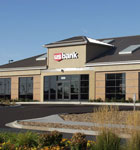Banks are rarely lumped together with smokestack industries in conversations about sustainability. But financial-sector buildings and operations can consume considerable resources—including at the retail end. The USGBC recognized this fact when it rolled out the LEED for Retail program in 2010. But U.S. Bank, a full-service financial-services firm based in Minneapolis, was already on the case, ranked by Bank Technology News in 2011 as among “America’s Greenest Banks” and one of only three banks in the top 100 of Newsweek’s “Greenest Companies” ranking.
Each freestanding retail location built since 2008—13 in total—has achieved LEED certification while sustainability practices are being rolled out in offices throughout the enterprise. Stand-alone retail structures are largely in U.S. Bank’s control, and its new buildings incorporate Energy Star mechanical systems, natural daylighting, reflective roofs, and recycled materials, among other elements. PCA Architecture designed many of its LEED branches, with project management coordinated by Cushman & Wakefield/NorthMarq.
“We’ve received a lot of positive feedback from our employees and customers about the green changes that have been made,” says Paul Gorham, U.S. Bank’s retail development director, corporate real estate.
A quarter of the bank’s retail operations are in non-traditional locations—grocery stores, hospitals, and airports—so heating and cooling are not in the bank’s control there, but environmentally friendly finishes, automation, and ergonomic furnishings have been phased in. In 2007, U.S. Bank formed an environmental stewardship council to assess where it was—and where it could go. “The council developed a comprehensive plan. We considered energy use, products, lending and investments, and employee-engagement policies,” says Greg Thorne, environmental manager, corporate real estate. Existing locations were upgraded “where most beneficial,” he says. “We looked at where energy use was highest, where costs were the greatest, and where the best incentives could be found.”
It’s a situation ripe with opportunity. Consider U.S. Bank’s 3,085 retail locations handling financial functions for businesses, individuals, and municipalities. Its more than 63,000 employees using computers and peripherals. Add in lighting for tasks, ambiance, and outdoor signage, and it’s easy to see how electricity usage adds up quickly. So the bank phased out old office automation and replaced it with all-in-one printer-scanner-photocopiers. It replaced old CRT screens with energy-efficient monitors, which resulted in notable energy savings. And it recently installed energy-efficient light fixtures and motion sensors in nearly 100 of its California locations, reducing power consumption at those sites by 1.3 million kilowatt-hours annually. Just this year, a recycling pick-up program was devised for smaller branches.
Retail customers also are engaged in conservation. Auto loans for EPA-certified “Smart Way” vehicles are offered at a half-percent rate reduction, and both loan and deposit customers are encouraged to use online banking and electronic statements.
The program is achieving its goals. In just two years—from 2008 to 2010—the bank reduced relative year-over-year energy use by four percent. Most industrial smokestacks now have scrubbers—at U.S. Bank, sustainability is more complex. But with an enterprise-wide plan designed to be adaptable throughout widely distributed locations, measurable results were delivered in just a few short years.


